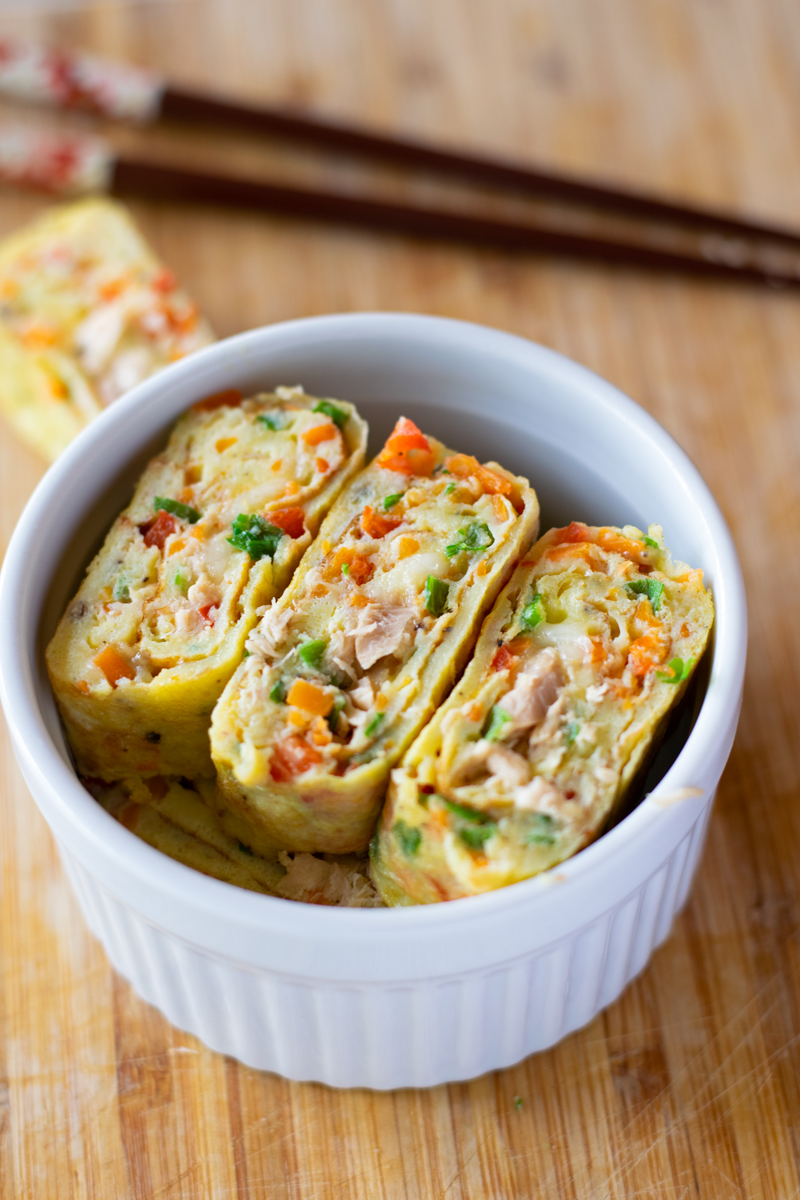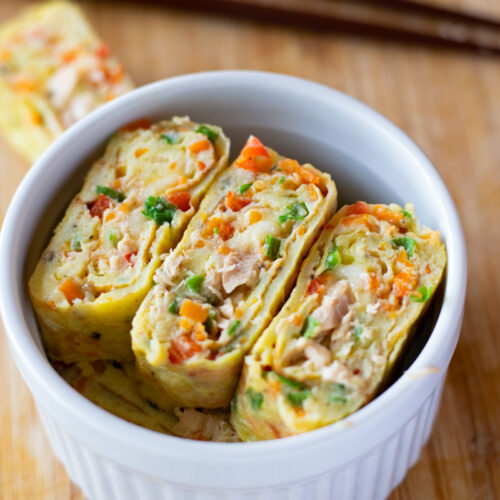Did you know that there's a Korean version of rolled omelettes? This recipe is the BTS of eggs. It's gonna make you dance and scream for more!

What is the difference between a Korean and Japanese rolled omelette?
It's the battle between gyeran mari and tamagoyaki!
The Korean version of rolled omelettes are very similar to the Japanese ones. I make both and love to eat them equally.
There are two main differences. The first is the vegetable fillings for the Korean version go directly into the raw egg mix before cooking. For Japanese tamagoyaki, there are either no fillings or the fillings go on the inside, like a burrito.
The second main difference is the seasoning. Tamagoyaki are typically seasoned with soy sauce, sugar, and mirin (a sweet cooking wine). There are sweet or savory versions. For example, the tamagoyaki served at sushi restaurants is the sweet version.
Dashi broth is also added to make dashimaki, which is one of the most common versions of tamagoyaki. The added dashi gives dashimaki its umami flavor.
Gyeran mari are seasoned to taste savory or slightly salty, rather than sweet.
I know, it's a lot remember if you don’t speak Japanese…or Korean.

Ingredients
- 3 eggs
- carrot
- bell pepper (red pepper)
- green onions (or the green stalk of spring onions)
- grass-fed butter (or your preferred neutral cooking like avocado oil)
- 1 can of tuna (optional: or crab meat, imitation crab meat)
- shredded mozzarella cheese (optional)
- salt
- black pepper

Other Popular Fillings Used in Korea
- seaweed sheets
- zucchini
- salted seafood
- bacon
- salted pollack roe
- chopped ham or SPAM
Add your favorite fillings
The options for fillings are endless. Depending on where you live and what's in season, you can modify and mix up the fillings you use. Just like toppings on your favorite pizza, it comes down to personal preference.
I recommend that you avoid adding vegetables that will release a lot of water when cooked. This would make your egg mixture too watery for rolling neatly. It would basically turn to slop.
For example, if you wanted to try making these with cherry tomatoes or cucumber, you'd want to remove the juicy insides first. Then remove as much moisture as possible.

Kitchen Tools Needed
- cutting board
- a sharp knife
- tamagoyaki pan (or non-stick pan)
- small bowl
- small spoon
- teaspoon and tablespoon
- metal sieve (optional)
- cooking chopsticks (optional)
- spatula
- paper towel (optional)

How to make Korean-style egg roll
Don't be intimated by how rolled omelettes look! Once you've tried a few times, they're really easy to make. I promise you, they're easier to make than they look.
While I prefer using a tamagoyaki pan, you can make these with a regular fry pan that you already have in your kitchen.
You don't even need to go out hunting to find special Korean ingredients. You can find everything you'll need at your small local supermarket or farmer's market.
If you follow my simple recipe below step-by-step, you should have no trouble making your first Korean-style omelette.

Cooking tips for your first time
If you’re making your first roll, here are some tips to save you from failure:
Note that if you have no experience cooking rolled omelettes, it does take some practice to get the hang of it. Once you got the technique down, you'll never forget how.
1) To prevent burning or overcooking your layers of eggs, cook at low heat. Depending on your stovetop, you can choose to turn it up to medium-low heat if needed.
2) If you've never used cooking chopsticks (the long ones), then it will be much easier to turn your roll with a wooden or rubber spatula.
3) Remove excess oil or melted butter with paper towel. You only want to use enough cooking oil or butter so the layers of eggs don't stick to your pan.
4) Cook eggs slowly to avoid burning. Have patience to avoid turning your roll too early and having it fall apart. Test it with your spatula. If the layer of egg doesn’t fold easily, that's an indication that your layer of egg needs to cook longer or the layer is too thin.
5) Let cool for 1-2 minutes at room temperature and then cut with a sharp knife on a cutting board. Using your sharpest knife will make cutting your rolled omelette, without crumbling pieces, much easier.

Korean Omelette Recipe
Ingredients
- 3 eggs
- 1.5 tbsp finely chopped carrot
- 1.5 tbsp finely chopped bell pepper (red)
- 1 tbsp finely chopped green onion tops
- 1 tsp butter (grass-fed)
- 2 tsp canned tuna optional
- 1 tbsp shredded mozzarella cheese optional
- 2 pinches salt
- ground black pepper to season
Instructions
Prep- Fillings
- Wash, peel, and finely chop carrot. Push chopped carrots aside on your cutting board. (About ½ of a medium-sized carrot)
- Wash bell pepper. Cut off a piece, about ¼ to ⅓ of pepper. Remove white pith and seeds. Finely chop pepper. Remove excess moisture by covering chopped pepper with paper towel and pressing down firmly with your hand. Then, push aside.
- Cut off and wash about 4 green tops (stems) of green onion. Finely slice and set aside.
- Open can of tuna and pour out liquid. Remove 3 tablespoons of tuna from can. Cover with paper towel and press down firmly to remove any excess moisture.
Prep- Eggs
- Crack 3 eggs into a small mixing bowl or Pyrex measuring cup. Whisk with a fork or cooking chopsticks until egg mixture is a uniform yellow color.
- Optional: Place a sieve on top of another mixing bowl. Pour egg mixture into sieve to remove the chalazae. Let it sit for a minute so all the yolk and egg white go through the sieve.
- Measure chopped vegetables with a tablespoon. Add to egg mixture.
- Season with salt and pepper and stir.
- Set egg mixture aside next to your stove.
Cooking
- Turn on stove burner to low heat.
- Coat tamagoyaki pan with butter. Holding the pan's handle, turn the fry pan back and forth and side to side to ensure all the corners get covered.
- Optional: Use some folded up paper towel to coat the sides of the pan with butter and remove any excess melted butter.
- With a fork or chopsticks, put a small amount of egg on the surface of the pan. If the egg sizzles, the pan is hot enough.
- Pour enough egg mixture in pan to make a thin layer. Slightly tilt the pan and forth and side to side so the egg coats the entire bottom of the pan.
- Once the first layer of egg is half cooked, use a small spoon add tuna on one-third of the layer of the egg. Make a line of tuna from from the long side to the other long side.
- Evenly sprinkle shredded mozzarella cheese on top of the tuna.
- With a spatula, roll up the first layer of omelette towards you to carefully wrap fillings inside. Keep rolling until you reach the end of the pan closest to you.
- Once completely rolled up, nudge the roll to the far side of the pan, away from you.
- Recoat the exposed pan with butter (if needed).
- Add the remaining egg mixture to the pan. Slightly lift up the roll with your spatula. Then, tilt the pan away from you so the egg mixture evenly coats the pan underneath the first omelette roll.
- Then, set down the pan flat. Once the next layer of egg is half-cooked, repeat the same rolling process towards you from step #8.
- Using your flat side of your spatula, gently press down on the top and sides to form the rolled omelette into a neat rectangular prism shape.
Plating
- Turn off stove. Use the spatula to gently put your rolled omelette on a cutting board.
- Let cool for a minute or two.
- Use a sharp knife to carefully slice the roll into 4-5 pieces. Using a gentle sawing motion to cut a line with your blade at a 45 degree angle. Then press firmly down with knife blade parallel to the cutting board.
- Serve warm or cool down to room temperature to add to your bento lunch box.
Notes
What to serve with a Korean omelette
From my research, it looks like Korean omelettes go with similar foods as rolled omelettes in Japan.
Most commonly, it's served with rice. This could be at breakfast time or next to rice in a bento box.
Next, probably just as common, is vegetables. This could mean a simple shredded cabbage salad, a green salad with dressing, a few raw pea pods, or a couple of fresh cherry tomatoes.
We're talking Korean food, so, of course, you can serve your omelettes with kimchi or namul. Namul are side dishes such as spinach or bean sprouts seasoned with sesame oil, salt, and garlic.
These are all simple and quick to prepare. Namul is made with only a handful of ingredients.
You can also serve Korean omelette with an additional protein like chicken or grilled fish. Even better, in my opinion, would be to serve with jjigae, a Korean spicy stew. Of course, this requires more time and commitment.
What I would do is order the jjigae takeaway from your favorite Korean restaurant. While you're waiting for your Uber to arrive, make one or two rolled omelettes that will be ready to serve.

How to Store
If you have any leftovers, which is unlikely, you can store the rest in the fridge. First, let your leftover pieces cool down to room temperature.
Keep them in an airtight container and throw 'em in the fridge. I recommend eating them for breakfast the following morning. Or pack them in your bento for lunch.
For freshness' sake, I wouldn't save them for more than that, 2-3 days max.
Yes, technically you can reheat them in a microwave, toaster, or oven. More commonly, in Korea and Japan, rolled omelettes are more often eaten at room temperature.
This is especially the case for leftovers or as part of your bento box.
Similar Recipes
Click on the links below to check out the full recipes:
Tamagoyaki Learn the basics for making tamagoyaki (with video). Find examples of different fillings you can try and nutrition info.
Tamagoyaki with fillings (Japanese rolled omelette) In this version, I used smoked salmon, blue cheese, and cooked spinach as fillings. If you'd prefer using your favorite fillings, you can still learn the basics of making a Japanese rolled omelette with fillings inside.
Western fusion tamagoyaki This is a more creative version to give you some inspiration. Filled with oatmeal, cinnamon, blueberries, and chopped almonds.


Leave a Reply